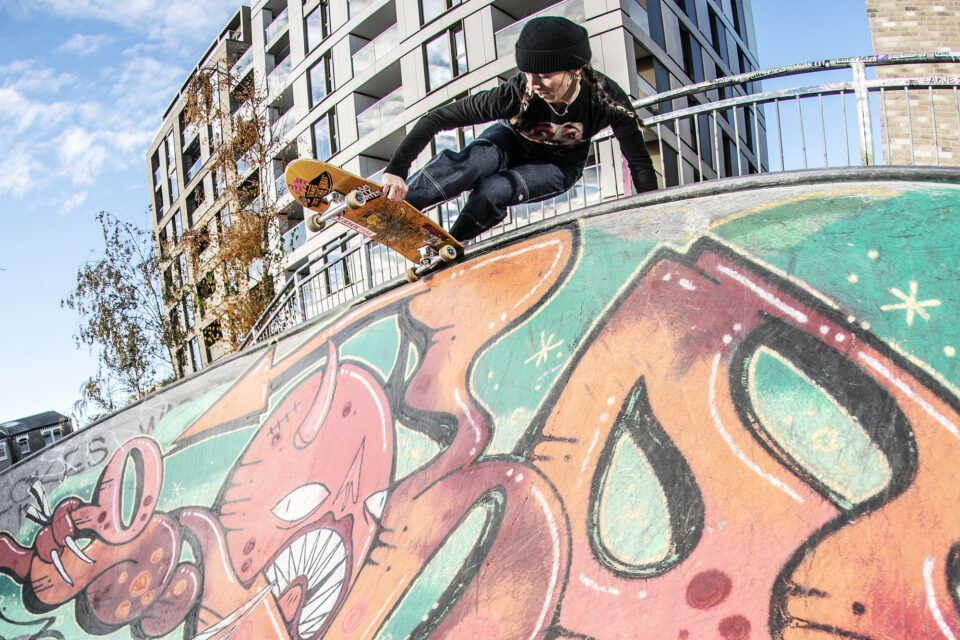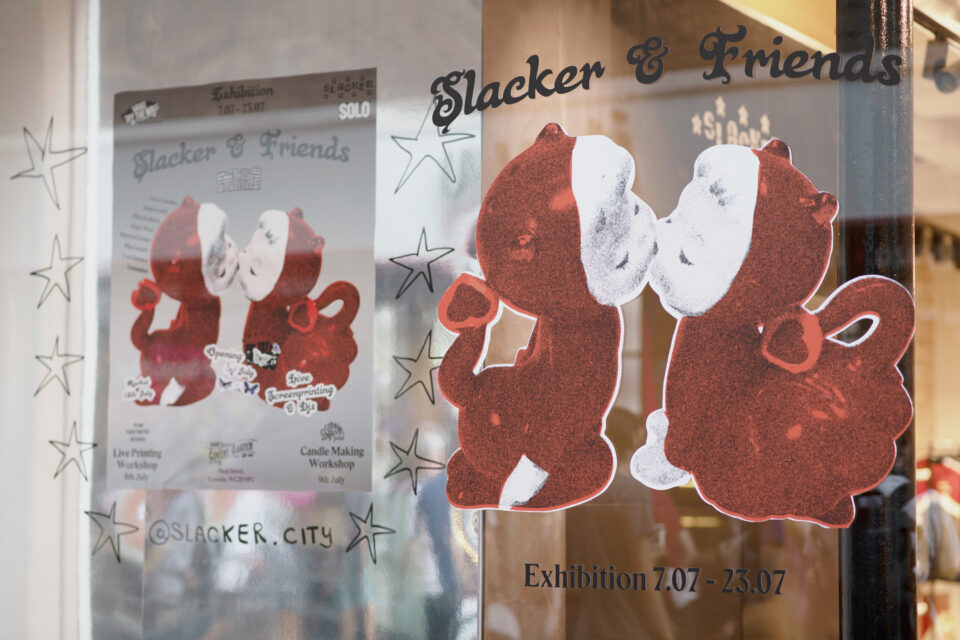Previous post

I HAVE THE BEST FRIENDS is a video by Greg King filmed at Hackney Bumps between 2022-23 & dedicated to friend of many at the Bumps, Baxter Lehanneur. We asked Bumps local Esther Sayers, who passed on a trip to San Diego in order to attend the premiere of I HAVE THE BEST FRIENDS, to write about the video. Esther spoke to Greg as well as Tom Lock & Harry Wilson, who helped with filming & editing.
Words: Sayers
Golden hour at the Bumps, and it’s empty, as we all cram into Hackney Baths, a repurposed swimming pool near the A12 DIY. Everyone is packed into the main hall, excited to finally see it, the atmosphere in there is wicked, the lights are dimming, everyone hushes, it begins. The opening scene is in slow motion, the effect is dreamlike as Baxter and Dex (Harrison) do doubles on the big quarter, a synchronised backside disaster, it’s beautiful. Baxter Lehanneur was a good friend to lots of people at the Bumps, he developed an aggressive cancer, which spread to the brain and caused seizures. Supported by his friends and able to communicate only through note writing Baxter wrote: “I HAVE THE BEST FRIENDS”. This film is dedicated to the memory of Baxter and acts as a celebration of the warmth and friendship that has built up around Hackney Bumps.
We are at the screening of I HAVE THE BEST FRIENDS, filmed and edited over a year by Greg King. It documents community-run skateboarding in east London. What’s special about the film is that it captures this precious feeling at the Bumps, a vibe of inclusivity. I chatted to Greg and some of the other people behind the film – Harry Wilson and Tom Lock, who were integrally involved in filming and editing – to gain some deeper understanding of the process.
This is a scene video. It captures the laughter, the joy, the mutual support and above all the sense of community that has grown at Hackney Bumps.
When it was first screened back in April 2023, I was due to be in San Diego speaking at a skate conference, but the pull of the screening and hanging with my Bumps family was too strong. I decided to miss the conference and go to the screening; it was a very good decision. It’s hard to describe the feeling of being part of a scene, the warmth of ‘family’, the validation of friends, the feeling of belonging, the joy, the pride, the instinct to protect, to nurture.
The film took a year to produce over which time enormous amounts of clips were captured and decisions made about editing, structure, sound and colour. The resulting film is nothing short of a masterpiece. Described as: “a duty of care to archive this magical moment” (Harry), the finished piece reminds us that filmmaking really is an art form. In contrast to the fast fix of a series of single moments on Instagram, the editing here is a work of curation, it takes us on a journey of friendships.
I met up with Greg to find out more about the process. I asked: “Why make a film?”
G – “You get the concentration of a year in 20 minutes. You get to feel the complexity of a skate scene through a skate video in a way that you can’t really get with social media. You interpret it in a different way.”
I am overwhelmed by how respectful it is, as it introduces each person and stays with them.
E – “Was there a reason for that?”
G – “The introduction to each person is intentional, because sometimes you watch skate videos and it’s telling you: “these are the big guys and these are the little guys”, the big guys get an intro and a bit of a fanfare and subtle things, like more run-up or run-out on a trick, and that gives emphasis. A lot of this we consciously get, but some of it you just watch and you’re not quite sure how it is done. I’m really aware how a cut can place emphasis on one bit more than another, deliberately.”
As a piece of film, it is shot in an ‘old school’ (or what is sometimes called ‘classic’) skate video style – predominantly 4:3 fisheye, with occasional long lens, and lots of Super 8. While this could make for a jumpy and disparate quality, the pace, the colour grading and the closeness of the camera all work to hold the film and the shots together in one continuous motion.
E – “Why did you decide to shoot it in this way?”
G – “The wideness and distortion make things directly in front of the lens get sucked in and things on the edges fade away. I wanted to incorporate dynamic movements, to add speed and dynamism. Keeping the camera as close as possible was the mantra: “If you’re not worried about the camera getting hit then you’re not close enough”. It felt like that kind of video: exciting and fun. It was planned, but, keeping it dynamic, moving, colourful and exciting was important. No locked off shots, no still shots. Keeping the camera moving before and after the trick and the same in the editing – cutting out any still bits, keeping the pace.”
E – “Why did you decide to shoot using predominantly fisheye?”
G – “I reckon to film well with fisheye you have to really be there in the mix, right next to the skater, you put the camera almost in the way of the skater and the board whizzes past your lens and face. For me skate vids with lots of fisheye express a feeling of kinship and trust.”
I also spoke about the process with Tom and Harry as they’d all been involved in the filming and the post-production. I was interested in how they’d filmed it because what really struck me at the screening was just how democratic it is. I asked whether there were deliberate filmmaking strategies to highlight inclusivity, whether the film consciously goes out to reflect the community in a certain way.
I can see that it does reflect the scene that has grown around the Bumps, and how that came from the project to renovate the surface, but paying attention to everyone and the inclusivity that brings has longer roots:
T – “I’ve known Greg since I was like 15. He was making videos back then and they had the same kind of vibe. He’s always had it within him to be a person that brings people together and holds them in a way. To be like: “You can do this trick”. He’s got the patience to stick with people and the videos he made back in the day had the same kind of inclusivity. The way that he has made this video: he’s been working in that way for a long time.”
This is not strategic community building. Bumps is more organic than that and equality is an intrinsic part of the vibe there.
G – “We started with that aim. There wasn’t really a scene, we started with a blank canvas and we all shared that vision. It’s a community hub and not just a skatepark.”
The origin of this scene was long before the Bumps got renovated and probably prior to any of us living in and around E5. I’ve lived around here for 24 years and somehow Hackney has always drawn in people who are committed to building something up and doing it together.
E – “What is particular or special about the Bumps and how has the scene emerged over time?”
T – “There is a culture around the Bumps that brings a certain kind of energy, potential, excitement and growth. I think it is the people, and it comes from the original idea that Nick and Greg had to turn it into a place that can be used again. It all stems from that.”
The way the renovation project started, right from the first meeting, was this gathering of a group of people who all shared the same drive. We all wanted to improve our local. Such a convivial, sharing culture doesn’t just happen out of thin air. It grows out of something.
Like many skateparks the Bumps is next to a children’s playground. This can create certain contradictions in the way it is to be used. Ostensibly you need wheels to play here, but at the same time, like all skate spaces, it confounds certain social norms about play being just for kids. These are places used by adults and children. About five minutes into the film the pace changes and the beautifully titled ‘YOUNGERS’ begins. One of the greatest successes is that now there is a young skate community growing up at the Bumps. It is hard to say how much a skate spot influences the scene that grows but would they have even started skating if the Bumps wasn’t there?
The visual language, the meaning that lingers behind shots, is all part of the explicit ideology that comes through skate videos. I HAVE THE BEST FRIENDS has many filmic devices and nods to skate video history.
G – “The funniest and the most intended is the freeze frame at the end because that’s not a thing that’s used anymore. If you go and watch skate videos from the ’60s and ’70s many of them end with a freeze frame.”
I HAVE THE BEST FRIENDS captures a moment in a scene at Hackney Bumps in east London. As Harry said: “This needed to happen to look at the new scene that is developing there. It is constantly evolving and progressing, so there’s a duty of care to capture this scene whilst it is around, and also to inspire the next generation.”
Whilst the film ends with a freeze frame, that’s only a filmic device. The timeline is always moving. Hackney Bumps is always open to new people coming in.
‘I HAVE THE BEST FRIENDS’ features, in order of appearance: Baxter Lehanneur, Dexter Harrison, Umar Muhammad, Christina Perzl, Marcus Stultz, Sam Murgatroyd, Charlie Allen, Joe Walker, Joseph Loughborough, Dom Alden, Ash Van’t Hoogerhuijs, Theo Krish, Danny Angles, Samuel, Mattioli, Ceesay Njie, Brian Anderson, Mark Gonzales, Józef Szklaruk, Ahmad Abdullahi, Laurie Sherman, Alejandro, Dominic, Bartek Milczarek, Remy Silvester, Valedina Chatira, Elliot Cunningham, Casper Cunningham, Edd Butterworth, Maite Steenhoudt, Pia Schiele, Jess Holland, Graham Callam, Michael Crozier, Amit Beeharee, Soren Paillou, Amanda Fordyce, Kaitlene Koranteng, Cai Serreau, Olmo Bellotti, Orlando Gangbo, Arlo Stallard-Watson, Bruno Cox, Luca Mutton, Heyes, Zeke Adamson, Pip Sangster, Josh Cole, Rich Ardagh, Diego Fernández, Jake Welch, James Sofokleous, Stu Smith, Matt Beck, Tommy Couzens, Nick Tombs, Greg King, Esther Sayers, Daryl Nobbs, Oly Higgs ,Sam Charlton, Giacomo Layet, Henry Edwards-Woods, Tom Lock, Rich Maskey, Sam Elstub, Denis Lynn, Harry Wilson, Alex Kite, Stuart Maclure, Soul Ayo Pelemo, Froby Juan, Jack James, Deimantė Sprainaitytė, Will Roberts, Taylor Jones, Kavita Babbar, Sol Gregory Cundy, Nelson Beesley, Billy Klofta, Dan Emmerson, Ned Kimber, Sol Dhariwal, Mikey Joyce, Rory Cunningham, Omar Christie, Tomek Cimoch, Elijah McKenzie, Tom Fuller, Duncan Fuller, Jack Hamilton, Reinaldo Mancero Rodriguez, Twyla Liden, Solene Riff & Chris Mann.
Read our 2020 article about the renovation of Hackney Bumps during the first lockdown here.

